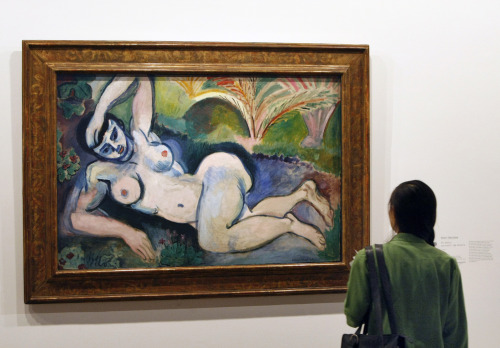
PARIS (AP) ― The lady with the crazy hat is back, 106 years after she scandalized Parisians. Nearby is another woman of scandal, reclining naked, her body strangely contorted and tinted blue.
These Matisse masterpieces are part of the art collection of writer Gertrude Stein and her brothers, Americans from San Francisco who set up in Paris and became legendary patrons of avant-garde art.
Some 200 paintings and other works acquired by the Steins go on display Wednesday at the sumptuous Grand Palais, where Matisse’s “Femme Au Chapeau” (Woman with a Hat) scandalized visitors during an art exhibit at the Grand Palais in 1905.
The show, on two floors, brings together masters who defined modern art ― Matisse, Picasso, Renoir, Degas, Cezanne, Manet. Along the way, it tells the story of the important role the Steins played in setting the direction of 20th century art.
Gertrude and her brother Leo, an art critic, lived on the Left Bank’s rue de Fleurus. Another brother Michael and his wife Sarah were nearby on rue Madame. They began befriending artists like Matisse and Picasso shortly after arriving in Paris after the turn of the century.
They soon were sought after by Parisian and American artists and intellectuals of all sorts, including writers F. Scott Fitzgerald and Ernest Hemingway, and set up Saturday salons at the rue de Fleurus to receive their guests ― the weekend place to be.
“I think that it was Leo’s eye that was the starting point for discovering Matisse, who wasn’t having a lot of success at the time, and the young Picasso who wasn’t exhibiting anywhere,” said Cecile Debray, curator of the exhibit “Matisse, Cezanne, Picasso ... The Stein Family.”
“Within a few years, really between 1905 and 1914, they put together the most fabulous collection of modern art that we can imagine,” she said.
Leo and Gertrude bought “La Femme au Chapeau.” That purchase “will immediately place the collection into the category of the avant-garde,” Debray said. This was “the beginning of a long patronage of (Matisse’s) art, his work, his radical approach to color.”
They also bought his “Nu Bleu: Souvenir de Biskra” (Blue Nude), which shocked the 1907 Salon des Independants. It’s a huge painting depicting a reclining woman daubed in blue with oversized breasts and hips. To underscore the radical vision in the painting, it is hung next to more classic nudes, including Bonnard’s 1900 “Siesta,” a sensual version of a woman seen from the back on her bed.
Even Picasso didn’t understand the “Blue Nude.” However, it ultimately had a profound influence on him that flowered in his famed painting “Les Demoiselles d’Avignon.”
Michael and Sarah ultimately became the main promoters of Matisse, while Gertrude befriended Picasso, collecting works from his rose and blue periods and pre-Cubist paintings like his 1907 “Nu a la Serviette” (Nude With a Towel).
The exhibit includes numerous portraits of the Steins by Picasso, as well as letters, photos of them and audio readings by Gertrude.
Gertrude Stein gained renown beyond the art world for her 1933 book, “Autobiography of Alice B. Toklas,” who joined her on the rue de Fleurus.
These Matisse masterpieces are part of the art collection of writer Gertrude Stein and her brothers, Americans from San Francisco who set up in Paris and became legendary patrons of avant-garde art.
Some 200 paintings and other works acquired by the Steins go on display Wednesday at the sumptuous Grand Palais, where Matisse’s “Femme Au Chapeau” (Woman with a Hat) scandalized visitors during an art exhibit at the Grand Palais in 1905.
The show, on two floors, brings together masters who defined modern art ― Matisse, Picasso, Renoir, Degas, Cezanne, Manet. Along the way, it tells the story of the important role the Steins played in setting the direction of 20th century art.
Gertrude and her brother Leo, an art critic, lived on the Left Bank’s rue de Fleurus. Another brother Michael and his wife Sarah were nearby on rue Madame. They began befriending artists like Matisse and Picasso shortly after arriving in Paris after the turn of the century.
They soon were sought after by Parisian and American artists and intellectuals of all sorts, including writers F. Scott Fitzgerald and Ernest Hemingway, and set up Saturday salons at the rue de Fleurus to receive their guests ― the weekend place to be.
“I think that it was Leo’s eye that was the starting point for discovering Matisse, who wasn’t having a lot of success at the time, and the young Picasso who wasn’t exhibiting anywhere,” said Cecile Debray, curator of the exhibit “Matisse, Cezanne, Picasso ... The Stein Family.”
“Within a few years, really between 1905 and 1914, they put together the most fabulous collection of modern art that we can imagine,” she said.
Leo and Gertrude bought “La Femme au Chapeau.” That purchase “will immediately place the collection into the category of the avant-garde,” Debray said. This was “the beginning of a long patronage of (Matisse’s) art, his work, his radical approach to color.”
They also bought his “Nu Bleu: Souvenir de Biskra” (Blue Nude), which shocked the 1907 Salon des Independants. It’s a huge painting depicting a reclining woman daubed in blue with oversized breasts and hips. To underscore the radical vision in the painting, it is hung next to more classic nudes, including Bonnard’s 1900 “Siesta,” a sensual version of a woman seen from the back on her bed.
Even Picasso didn’t understand the “Blue Nude.” However, it ultimately had a profound influence on him that flowered in his famed painting “Les Demoiselles d’Avignon.”
Michael and Sarah ultimately became the main promoters of Matisse, while Gertrude befriended Picasso, collecting works from his rose and blue periods and pre-Cubist paintings like his 1907 “Nu a la Serviette” (Nude With a Towel).
The exhibit includes numerous portraits of the Steins by Picasso, as well as letters, photos of them and audio readings by Gertrude.
Gertrude Stein gained renown beyond the art world for her 1933 book, “Autobiography of Alice B. Toklas,” who joined her on the rue de Fleurus.





![[Music in drama] Rekindle a love that slipped through your fingers](http://res.heraldm.com/phpwas/restmb_idxmake.php?idx=644&simg=/content/image/2024/05/01/20240501050484_0.jpg&u=20240501151646)




![[New faces of Assembly] Architect behind ‘audacious initiative’ believes in denuclearized North Korea](http://res.heraldm.com/phpwas/restmb_idxmake.php?idx=644&simg=/content/image/2024/05/01/20240501050627_0.jpg&u=20240502093000)







![[Today’s K-pop] Stray Kids go gold in US with ‘Maniac’](http://res.heraldm.com/phpwas/restmb_idxmake.php?idx=642&simg=/content/image/2024/05/02/20240502050771_0.jpg&u=)